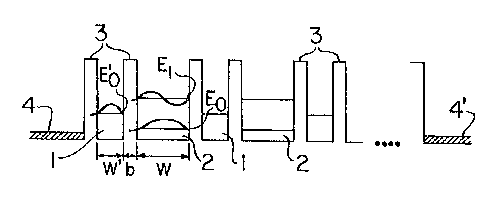Une partie des informations de ce site Web a été fournie par des sources externes. Le gouvernement du Canada n'assume aucune responsabilité concernant la précision, l'actualité ou la fiabilité des informations fournies par les sources externes. Les utilisateurs qui désirent employer cette information devraient consulter directement la source des informations. Le contenu fourni par les sources externes n'est pas assujetti aux exigences sur les langues officielles, la protection des renseignements personnels et l'accessibilité.
L'apparition de différences dans le texte et l'image des Revendications et de l'Abrégé dépend du moment auquel le document est publié. Les textes des Revendications et de l'Abrégé sont affichés :
| (12) Brevet: | (11) CA 1299719 |
|---|---|
| (21) Numéro de la demande: | 1299719 |
| (54) Titre français: | SOURCE INFRAROUGE A SUPER-RESEAU SEMICONDUCTEUR |
| (54) Titre anglais: | SEMICONDUCTOR SUPERLATTICE INFRARED SOURCE |
| Statut: | Périmé et au-delà du délai pour l’annulation |
| (51) Classification internationale des brevets (CIB): |
|
|---|---|
| (72) Inventeurs : |
|
| (73) Titulaires : |
|
| (71) Demandeurs : |
|
| (74) Agent: | R. JOHN HALEYHALEY, R. JOHN |
| (74) Co-agent: | |
| (45) Délivré: | 1992-04-28 |
| (22) Date de dépôt: | 1989-01-13 |
| Licence disponible: | S.O. |
| Cédé au domaine public: | S.O. |
| (25) Langue des documents déposés: | Anglais |
| Traité de coopération en matière de brevets (PCT): | Non |
|---|
| (30) Données de priorité de la demande: | S.O. |
|---|
TITLE
SEMICONDUCTOR SUPERLATTICE INFRARED SOURCE
INVENTORS
HUI CHUN LIU
ABSTRACT
An infrared emitting semiconductor device having
a layer-shaped infrared emitting region with a superlattice
structure. The superlattice structure consists of thin alternating
narrow and wide wells separated by thin barriers. The narrow
well has one quasibound state E'0 while the wide well has two
states E0 and E1 with E0' being located between E0 and E1.
Under proper bias, an electron in state E0 can resonately tunnel
out of the well through the quasibound state E'0 to the first
excited state E1 of the next wide well. This electron can
then relax to the ground state E0 where it can resonately tunnel
to the next wide well and repeat the process. Infrared radiation
with its photon energy equal to E1-E0 is emitted as the electrons
relax from E1 to E0 in the wide wells.
Note : Les revendications sont présentées dans la langue officielle dans laquelle elles ont été soumises.
Note : Les descriptions sont présentées dans la langue officielle dans laquelle elles ont été soumises.

2024-08-01 : Dans le cadre de la transition vers les Brevets de nouvelle génération (BNG), la base de données sur les brevets canadiens (BDBC) contient désormais un Historique d'événement plus détaillé, qui reproduit le Journal des événements de notre nouvelle solution interne.
Veuillez noter que les événements débutant par « Inactive : » se réfèrent à des événements qui ne sont plus utilisés dans notre nouvelle solution interne.
Pour une meilleure compréhension de l'état de la demande ou brevet qui figure sur cette page, la rubrique Mise en garde , et les descriptions de Brevet , Historique d'événement , Taxes périodiques et Historique des paiements devraient être consultées.
| Description | Date |
|---|---|
| Inactive : CIB en 1re position | 2020-04-03 |
| Inactive : CIB attribuée | 2020-04-03 |
| Inactive : CIB expirée | 2010-01-01 |
| Inactive : CIB enlevée | 2009-12-31 |
| Le délai pour l'annulation est expiré | 2008-04-28 |
| Lettre envoyée | 2007-04-30 |
| Inactive : CIB de MCD | 2006-03-11 |
| Inactive : Demande ad hoc documentée | 1998-04-28 |
| Lettre envoyée | 1997-04-28 |
| Accordé par délivrance | 1992-04-28 |
Il n'y a pas d'historique d'abandonnement
| Type de taxes | Anniversaire | Échéance | Date payée |
|---|---|---|---|
| TM (catégorie 1, 6e anniv.) - générale | 1998-04-28 | 1998-04-14 | |
| TM (catégorie 1, 7e anniv.) - générale | 1999-04-28 | 1999-03-08 | |
| TM (catégorie 1, 8e anniv.) - générale | 2000-04-28 | 2000-01-13 | |
| TM (catégorie 1, 9e anniv.) - générale | 2001-04-30 | 2001-04-03 | |
| TM (catégorie 1, 10e anniv.) - générale | 2002-04-29 | 2002-04-10 | |
| TM (catégorie 1, 11e anniv.) - générale | 2003-04-28 | 2003-04-25 | |
| TM (catégorie 1, 12e anniv.) - générale | 2004-04-28 | 2004-03-29 | |
| TM (catégorie 1, 13e anniv.) - générale | 2005-04-28 | 2005-04-21 | |
| TM (catégorie 1, 14e anniv.) - générale | 2006-04-28 | 2006-04-07 |
Les titulaires actuels et antérieures au dossier sont affichés en ordre alphabétique.
| Titulaires actuels au dossier |
|---|
| NATIONAL RESEARCH COUNCIL OF CANADA |
| HUI CHUN LIU |
| Titulaires antérieures au dossier |
|---|
| S.O. |